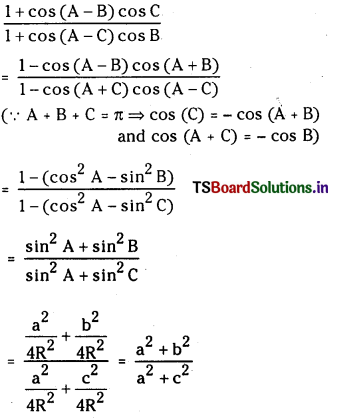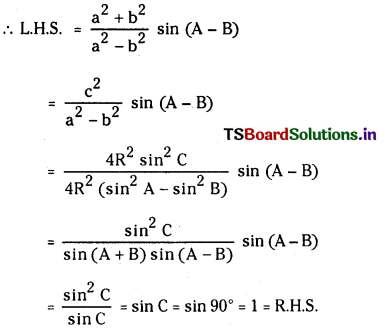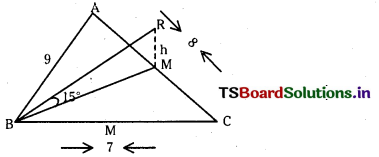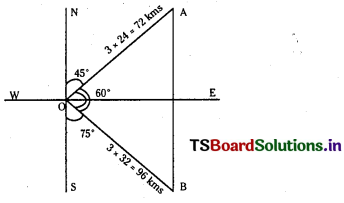Students must practice these TS Intermediate Maths 1A Solutions Chapter 10 Properties of Triangles Ex 10(a) to find a better approach to solving the problems.
TS Inter 1st Year Maths 1A Properties of Triangles Solutions Exercise 10(a)
(Note : All problems in this exercise refer to ∆ABC)
I.
Question 1.
Show that Σa (sin B – sin C) = 0
Answer:
L.H.S. = Σa (sin B – sin C)
= Σa \(\left(\frac{b}{2 R}-\frac{c}{2 R}\right)\) (∵ a = 2R sin A, b = 2R sin B, c = 2R sin C)
= \(\frac{1}{2 R}\) Σa(b – c)
= \(\frac{1}{2 R}\) [a(b – c) + b(c – a) + c(a – b)]
= 0 = R.H.S.
![]()
Question 2.
If a = √3 + 1 cm, ∠B = 30°, ∠C = 45°, then find c.
Answer:
Given ∠B = 30°, ∠C = 45°, a = √3 + 1, we have ∠A = 180° – (30 + 45) = 180° – 75° = 105°

Question 3.
If a = 2 cm, b = 3 cm, c = 4 cm, then find cos A.
Answer:
Given a = 2cm, b = 3 cm, c = 4 cm.
cos A = \(\frac{b^2+c^2-a^2}{2 b c}\)
= \(\frac{9+16-4}{2(3)(4)}=\frac{21}{24}=\frac{7}{8}\)
Question 4.
If a = 26 cm, b = 30 cm and cos C = \(\frac{63}{65}\) then find c. (Mar. 2011)
Answer:
By the formula c2 = a2 + b2 – 2ab cos C
c22 = (26)2 + (30)2 – 2 (26) (30)
= 676 + 900 – 1512
= 1576 – 1512 = 64
c = 8 cm
Question 5.
If the angles are in the ratio 1:5:6, then find the ratio of its sides. (May 2007)
Answer:
Given A : B : C = 1 : 5 : 6
∴ \(\frac{\mathrm{A}}{1}=\frac{\mathrm{B}}{5}=\frac{\mathrm{C}}{6}\) = B = C 1 “ 5 “ 6
A + B + C = 180° ;
⇒ A + 5A + 6A = 180°
⇒ 12 A = 180° ⇒ A = 15°
Ratio of sides = a : b : c
= sin A : sin B : sin C
= sin 15° : sin 75° : sin 90°
= \(\frac{\sqrt{3}-1}{2 \sqrt{2}}: \frac{\sqrt{3}+1}{2 \sqrt{2}}\) : 1
= √3 – 1 : √3 + 1 : 2√2
Question 6.
Prove that 2(bc cos A + ca cos B + ab cos C) = a2 + b2 + c2. (Mar. 2005)
Answer:
L.H.S. = Σ 2bc cos A
= Σ 2bc \(\left(\frac{b^2+c^2-a^2}{2 b c}\right)\)
= Σ (b2 + c2 – a2)
= b2 + c2 – a2 + c2 + a2
= a2 + b2 + c2
= R.H.S.
Question 7.
Prove that \(\frac{a^2+b^2-c^2}{c^2+a^2-b^2}=\frac{\tan B}{\tan C}\)
Answer:
Use c2 = a2 + b2 – 2ab cos C and
b2 = c2 + a2 – 2ca cos B in L.H.S. then

![]()
Question 8.
Prove that (b + c) cos A + (c + a) cos B + (a + b) cos C = a + b + c.
Answer:
L.H.S. = (b + c) cos A + (c + a) cos B + (a + b) cos C
= (b cos A + a cos B) + (c cos A + a cos C) + (b cos C + c cos B)
= c + b + a = a + b + c = R.H.S. (Use projection formula)
Question 9.
Prove that (b – a cos C) sin A = a cos A sin C. (Mar. 2006)
Answer:
L.H.S. = (b – a cos C) sin A
= (a cos C + c cos A – a cos C) sin A
= c cos A sin A
= 2R sin C cos A sin A
= (2R sin A) cos A sin C
= a cos A sin C = R.H.S.
Question 10.
If 4, 5 are two sides of a triangle and the included angle is 60°, find its area.
Answer:
Let a = 4, b = 5 both sides and angle between them be C = 60° then area of ∆ABC,
∆ = \(\frac{1}{2}\) ab sin C
= \(\frac{1}{2}\) (4) (5) sin 60°
= 10 \(\left(\frac{\sqrt{3}}{2}\right)\) = 5√3 sq. cm.
Question 11.
Show that b cos2 \(\frac{C}{2}\) + c cos2 \(\frac{B}{2}\) = s.
Answer:

Question 12.
If \(\frac{a}{\cos A}=\frac{b}{\cos B}=\frac{c}{\cos C}\), then show that ∆ABC is equilateral.
Answer:

⇒ tan A = tan B = tan C
⇒ A = B = C
⇒ ∆ ABC is an equilateral triangle.
II.
Question 1.
Prove that a cos A + b cos B + c cos C = 4R sin A sin B sin C.
Answer:
L.H.S. = a cos A + b cos B + c cos C
= Σ a cos A
= Σ 2R sin A cos A
= R Σ sin 2A
= R [sin 2A + sin 2B + sin 2C]
= R [sin 2A + 2 sin (B + C) cos (B – C)]
= R [2 sinA cosA + 2 sin A cos(B – C)]
(∵ A + B + C = 180° ⇒ sin (B + C) = sin A)
= 2R sin A [cos A + cos (B – C)]
= 2R sin A[- cos(B + C) + cos(B – C)]
= 2R sin A [cos (B – C) – cos (B + C)]
= 2R sin A (2 sin B sin C)
= 4R sin A sin B sin C = R.H.S.
![]()
Question 2.
Prove that Σa3 sin (B – C) = 0.
Answer:
L.H.S. = Σa3 sin (B – C)
= Σa2. a sin (B – C)
= Σa2 (2R sin A) sin (B – C)
= 2R Σa2 sin A sin (B – C)
= R Σa2 2 sin (B + C) . sin (B – C)
(∵ A + B + C = π, sin (B + C) = sin A)
= R Σa2 2(sin2B – sin2C)

Question 3.
Prove that
\(\frac{a \sin (B-C)}{b^2-c^2}=\frac{b \sin (C-A)}{c^2-a^2}=\frac{c \sin (A-B)}{a^2-b^2}\)
Answer:

Question 4.
Prove that Σa2 \(\frac{\sin (B-C)}{\sin B+\sin C}\) = 0
Answer:

= Σ a(b – c)
= a(b – c) + b(c – a) + c(a – b)
= 0 = R.H.S.
![]()
Question 5.
Prove that
\(\frac{a}{b c}+\frac{\cos A}{a}=\frac{b}{c a}+\frac{\cos B}{b}=\frac{c}{a b}+\frac{\cos C}{c}\)
Answer:

Question 6.
Prove that
\(\frac{1+\cos (A-B) \cos C}{1+\cos (A-C) \cos B}=\frac{a^2+b^2}{a^2+c^2}\)
Answer:

Question 7.
If C = 60°, then show that
(i) \(\frac{a}{b+c}+\frac{b}{c+a}\) = 1
(ii) \(\frac{b}{c^2-a^2}+\frac{a}{c^2-b^2}\) = 0
Answer:
C = 60° ⇒ c2 = a2 + b2 – 2ab cos C
= a2 + b2 – 2ab (cos 60°)
= a2 + b2 – 2ab (½)
= a2 + b2 – ab ……………….. (1)
(i)

![]()
(ii)

Question 8.
If a : b : c = 7 : 8 : 9, find cos A : cos B : cos C.
Answer:

Question 9.
Show that
\(\frac{\cos A}{a}+\frac{\cos B}{b}+\frac{\cos C}{c}=\frac{a^2+b^2+c^2}{2 a b c}\)
Answer:

Question 10.
Prove that (b – a) cos C + c (cos B – cos A)
= c sin \(\left(\frac{A-B}{2}\right)\) cosec \(\left(\frac{A+B}{2}\right)\)
Answer:
L.H.S. = (b – a) cos C + c (cos B – cos A)
= b cos C – a cos C + c cos B – c cos A
= (b cos C + c cos B) – (a cos C + c cos A)
= a – b
= 2R (sin A – sin B)
(using Projection and sine rule)

![]()
Question 11.
Express a sin2\(\frac{C}{2}\) + c sin2 \(\frac{A}{2}\) in terms of s, a, b, c.
Answer:

Question 12.
If b + c = 3a, then find the value of cot \(\frac{B}{2}\) cot \(\frac{C}{2}\).
Answer:
2s = a + b + c = a + 3a = 4a ⇒ s = 2a

Question 13.
Prove that
(b + c) cos \(\left(\frac{B+C}{2}\right)\) = a cos \(\left(\frac{B-C}{2}\right)\).
Answer:

![]()
Question 14.
In a ∆ABC show that \(\frac{b^2-c^2}{a^2}=\frac{\sin (B-C)}{\sin (B+C)}\)
Answer:

III.
Question 1.
Prove that
(i) cot \(\frac{A}{2}\) + cot \(\frac{B}{2}\) + cot \(\frac{C}{2}\) = \(\frac{s^2}{\Delta}\)
Answer:
Using the formulae

(ii) tan\(\frac{A}{2}\) + tan \(\frac{B}{2}\) + tan\(\frac{C}{2}\) = \(\frac{b c+c a+a b-s^2}{\Delta}\)
Answer:

![]()
(iii)

Answer:

Question 2.
Show that
(i) Σ(a + b) tan\(\left(\frac{A-B}{2}\right)\) = 0.
Answer:
We have Napler’s analogy as

![]()
(ii) \(\frac{b-c}{b+c}\) cot \(\frac{A}{2}\) + \(\frac{b+c}{b-c}\) tan \(\frac{A}{2}\) = 2 cosec (B – C).
Answer:
We have using Napler’s rule

Question 3.
(i) If sin θ = \(\frac{a}{b+c}\), then show that cos θ = \(\frac{2 \sqrt{b c}}{b+c}\) cos \(\frac{A}{2}\). (May 2014, Mar.12)
Answer:
We have cos2θ = 1 – sin2θ
= 1 – \(\frac{a^2}{(b+c)^2}\)

(ii) If a = (b + c) cos θ, then prove that sin θ = \(\frac{2 \sqrt{b c}}{b+c}\) cos \(\frac{A}{2}\).
Answer:

![]()
(iii) For any angle θ, show that
a cos θ = b cos (C + θ) + c cos (B – θ).
Sol.
R.HS. = b cos (C + θ) + c cos (B – θ)
= b (cos C cos θ – sin C sin θ) + c(cos B cos θ + sin B sin θ)
= (b cos C + C cos B) cos θ – sin θ(- c sin B – b sin C)
= a cos θ + sin θ(- b sin C + c sin B)
= a cos θ +(- 2R sin B sin θ sin C + 2R sin B sin C sin θ)
= a cos θ (∵ a = b cos C + c cos B)
Question 4.
If the angles of ∆ ABC are in A.P. and b : c = √3 : √2 , then show that A = 75°.
Answer:
Given A, B, C are in A.P
⇒ 2B = A + C
∴ A + B + C = π ⇒ 3B = π ⇒ B = 60°
Also b : c = √3 : √2

Question 5.
If \(\frac{a^2+b^2}{a^2-b^2}\) = \(\frac{\sin C}{\sin (A-B)}\), prove that ∆ABC is either isosceles or right angled.
Answer:

⇒ 2R sin A cos A = 2R sin B cos B
⇒ R sin 2A = R sin 2B
⇒ sin 2A – sin 2B = 0
∴ ∆ ABC is isosceles.
(or) 2A = 180° – 2B ⇒ A + B = 90°
Hence A ≠ B
⇒ ∆ABC is a right angled triangle.
∴ ∆ ABC is either isosceles or right angled.
![]()
Question 6.
If cos A + cos B + cos C = \(\frac{3}{2}\), then show that the triangle is equilateral.
Answer:

Question 7.
If cos2 A + cos2 B + cos2 C = 1, then show that ∆ ABC is right angled.
Answer:
Given cos2 A + cos2 B + cos2 C = 1 ……………. (1)
∴ cos2 A + cos2 B + cos2 C
= cos2 A + cos2 B + 1 – sin2 C
= 1 + cos2 A + cos (B + C) cos (B – C).
= 1 + cos2 A – cos A cos (B – C)
= 1 + cos A [cos (A) – cos (B – C)]
= 1 – cos A [cos (B + C) + cos (B – C)]
= 1 – 2 cos A cos B cos C
(∵ A + B + C = π, cos (B + C) = – cos A)
∴ 1 – 2 cos A cos B cos C = 1
⇒ 2 cos A cos B cos C = 0
⇒ A = 90° or B = 90° or C = 90°
⇒ ∆ ABC is right angled.
Question 8.
If a2 + b2 + c2 = 8R2, then prove that the triangle is right angled. (June 2001)
Answer:
Given a2 + b2 + c2 = 8R2
⇒ 4R2 (sin2 A + sin2 B + sin2 C) = 8R2
⇒ sin2 A + sin2 B + sin2 C = 2 ………………. (1)
Consider sin2 A + sin2 B + sin2 C
= sin2 A + sin2 B + 1 – cos2 C
= 1 + sin2 A + sin2 B – cos2 C
= 1 + sin2 A – (cos2 C – sin2 B)
= 1 + sin2 A – cos (B + C) cos (B – C)
= 1 + sin2 A + cos A cos (B – C)
(∵ cos (B + C) = cos (180 – A)° = – cos A)
= 1 + 1 – cos2 A + cos A cos (B – C)
= 2 + cos A [cos (B – C) – cos A]
= 2 + cos A [cos (B – C) + cos (B + C)]
= 2 + 2 cos A cos B cos C ……………… (2)
∴ From (1) we have
2 + 2 cos A cos B cos C = 2
⇒ 2 cos A cos B cos C = 0
⇒ cos A = 0 or cos B = 0 or cos C = 0
⇒ A = \(\frac{\pi}{2}\) or B = \(\frac{\pi}{2}\) or C = \(\frac{\pi}{2}\)
∴ ∆ ABC is right angled.
![]()
Question 9.
If cot \(\frac{A}{2}\), cot \(\frac{B}{2}\), cot \(\frac{C}{2}\) are in A.P., then prove that a, b, c are in A.P.
Answer:
cot \(\frac{A}{2}\), cot \(\frac{B}{2}\), cot \(\frac{C}{2}\) are in A.P.
⇒ \(\frac{s(s-a)}{\Delta}, \frac{s(s-b)}{\Delta}, \frac{s(s-c)}{\Delta}\) are in A.P.
⇒ (s – a), (s – b), (s – c) are in A.P.
⇒ – a, – b, – c are in A.P.
⇒ a, b, c are in A.P.
Question 10.
If sin2\(\frac{A}{2}\), sin2\(\), sin2\(\) are in H.P., then show that a, d, c are in H.P.
Answer:

Question 11.
If C = 90°, then prove that
\(\frac{a^2+b^2}{a^2-b^2}\) sin (A – B) = 1.
Answer:
Given C = 90° and c2 = a2 + b2 – 2ab cos C.
⇒ c2 = a2 + b2

Question 12.
Show that \(\frac{a^2}{4}\) sin 2C + \(\frac{a^2}{4}\) sin 2A = ∆.
Answer:

= 2R2 sin2 A sin C cos C + 2R2 sin2 C sin A cos A
= 2R2 sin A sin C (sin A cos C + cos A sin C)
= 2R2 sin A sin C sin (A + C)
= 2R2 sin A sin C sin B
(∵ A + B + C = π ⇒ sin (A + C) = sin B)
= ∆ = R.H.S.
![]()
Question 13.
A lamp post is situated at the middle point M of the side AC of a triangular plot ABC with BC = 7 m, CA = 8 m and AB = 9 m. Lamp post subtends an angle 15° at the point B. Find the height of the lamp post.
Answer:

Let MR = h be the height of the lamp post and MR = h.
From ∆BMR, tan 15° = \(\frac{\mathrm{h}}{\mathrm{BM}}\)
∴ h = (2 – √3) BM ……………… (1)

Question 14.
Two ships leave a port at the same time. One goes 24 km per hour in the direction N 45° E and other travel 32 kms per hour in the direction S 75° E. Find the distance between the ships at the end of 3 hours.
Answer:

The first ship goes 24 km/hr.
∴ After 3 hrs. first ship goes 72 kms.
The second ship goes 32 km/hr.
∴ After 3 hrs. second ship goes 96 kms.
Let AB = x be the distance between the ships.
From the geometry of the figure ∠AOB = 60°
Using cosine rule in ∆AOB we have
cos 60° = \(\frac{(72)^2+(96)^2-x^2}{2(72)+(96)}\)
⇒ \(\frac{1}{2}\) = \(\frac{5184+9216-x^2}{13824}\)
⇒ 13824 = 28800 – 2x2
⇒ 2x2 = 14976
⇒ x2 = 7488
⇒ x = 86.4 (approximate)
At the end of 3 hours the difference between the ships is 86.4 kms.
![]()
Question 15.
A tree stands vertically on the slant of the hill. From a point A on the ground 35 metres down the hill from the base of the tree, the angle of elevation of the top of the tree is 60°. If the angle of elevation of the foot of the tree from A is 15°, then find the height of the tree.
Answer:

Let BC = h be the height of the tree. AL is the slant of hill.
Let BD = x and AD = y and given AB = 35 m
∴ From ∆ADB, sin 15° = \(\frac{x}{35}\)
⇒ x = 35\(\left(\frac{\sqrt{3}-1}{2 \sqrt{2}}\right)\)
Also cos 15° = \(\frac{\mathrm{y}}{35}\)

Question 16.
The upper 3/4th portion of a vertical pole subtends an angle tan-13/5 at a point in the horizontal plane through its foot and at a distance of 40 m from the foot. Given that the vertical pole is at a height less than 100 m from the ground, find its height.
Answer:

From the figure AB is the vertical pole of height ‘h’.
∠BCD = θ, suppose ∠DCA = α and ∠BCA = β.
Also AC = 40 m ; given tan θ = 3/5

![]()
Question 17.
AB is a vertical pole with B at the ground level and A at the top. A man finds that the angle of elevation of the point A from a certain point C on the ground is 60°. He moves away from the pole along the line BC to a point D such that CD = 7 m. From D, the angle of elevation of the point A is 45°. Find the height of the pole.
Answer:

Let AB = ‘h’ be the height of the pole.
Given CD = 7
∠ACB = 60°, ∠ADB = 45° and line BC = x.

Question 18.
Let an object be placed at some height h cm and let P and Q be two points of observation which are at a distance of 10 cm apart on a line inclined at angle 15° to the horizontal. If the angles of elevation of the object from P and Q are 30° and 60° respectively then find h.
Answer:

Let AB = h cm be the height of the tower P and Q are points of observations.
From the geometry of the figure ∠BPA = 30° given ∠BPQ = 15°. Also ∠PQB = 135°.
∴ ∠PBQ = 30°, PQ = 10 cm (given).
In the ∆PQB, applying sine rule.
